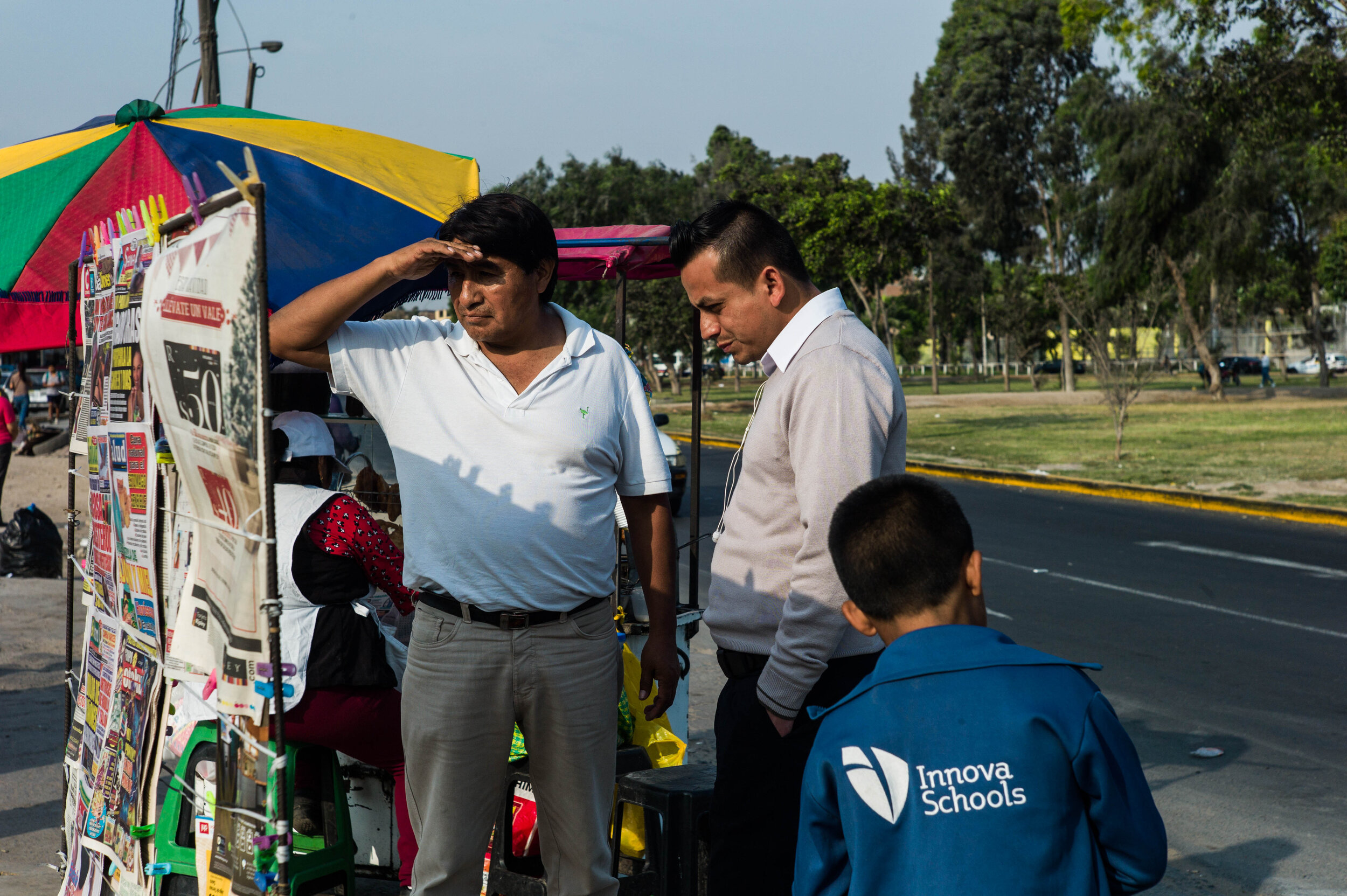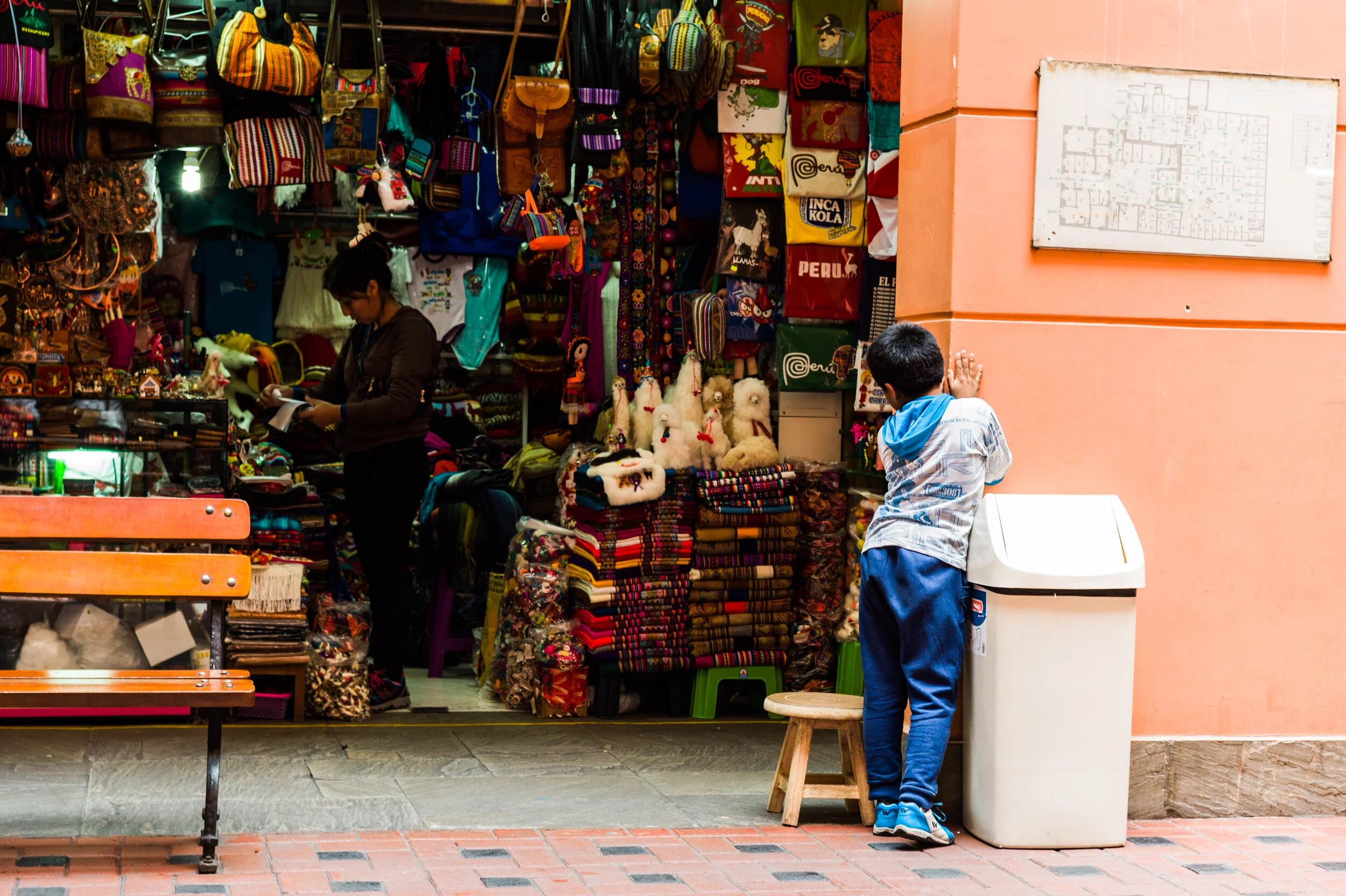
The city of Lima is located on the Pacific coast. This is a view from the coast line of one of Lima's most modern and cosmopolitan neighborhoods, Miraflores.


San Cristobal hill, the top of which is one of Lima's highest points. The informal urbanization of the hill by immigrants was among the first ones to take place in the 1950s. It is within walking distance from the historical center of Lima (founded in 1532). Much of this urbanization process, like the great majority of Lima, began without the aid of the government, and it was done through association of migrants, whose members usually migrated from the same areas of the country and who could easily establish networks of mutual collaboration.

Sunset view in Malecón Cisneros (Miraflores)

In terms of space, the city of Lima is at least 7 times bigger than "modern Lima". In this picture one can see the tall buildings of Miraflores and San Isidro in the distance, close to the sea. Lima is built on a "wet dessert," a desert with little access to potable water, with soft land, but with high levels of humidity. The city has as its natural boundaries the sea on the west, and the tall mountains that slowly become part of the Andes on the east.

Looking to the other side (towards the east) it is possible to see how the city has grown to urbanize the hill sides. This growth occurred starting in the 1940s, when mass migrations from the countryside of Peru began to take place. The city of Lima had roughly 300,000 inhabitants in the mid 1940s, but its population has grown to be almost a total of 10 million in 2017. Nowadays 33% of the entire population of Peru lives in Metropolitan Lima. The city was neither structurally nor culturally prepared for this enormous change in little over 50 years.

Scene at El Silencio beach, in the southern district of Punta Hermosa.


Two women talking. Historical Center of Lima.

Food and happiness. Banner displaying various dishes for sale at food stand (taken at Mistura gastronomic festival)

Night scene. Avenida Larco, Miraflores.

Lunch time outside. Plaza San Martín, Historical Center of Lima.

Throughout the city, it is very common to find sellers of desserts, quick foods and traditional sweets. In this case, a vendor of pineapple slices near Plaza San Martín, in the Historical Center of Lima.

Vendors having a break. Mercado Central, Historical Center of Lima

Tourist market. Various “Peruvian” (mostly Andean) crafts and gifts for tourists. Many of these have words related to Peruvian food (such as “ceviche”) or the logo of “Marca Perú”

D’onofrio ice cream vendors. They are ubiquituous in the city, going around in their tricycles. Photo taken in Barranco.

Fruits vendor. Mercado Central, Historical Center of Lima

Sweets street vendor offering his products to bus passengers.

Since the early 2000s, amid widespread allegations of corruption by the police (especially taking bribes from drivers), the national police corps began incorporating more women into its ranks, alluding to the fact that women were less corruptible than their male counterparts. Nowadays, women still account for less than 20% of the national police force, but the great majority of transit police in Lima are women.

Street seller of “humitas” (an Andean sweet made of corn). Outside of the bus terminal in La Victoria.

Scene at the Museum of Contemporary Art, Barranco

Worker taking a break. Gamarra market, La Victoria

Pop corn and sweet peanuts seller, offering her goods to bus riders. San Isidro.



Gamarra textile market. One of Peru’s most important economic centers, in La Victoria. Due to the enormous amount of money the market generates everyday, the cost of renting a commercial space per square meter is the highest in all of Peru.









Fruit seller next to a pirated DVDs seller in Gamarra



Avenida Pardo, Miraflores

Malecón Cisneros, Miraflores.



Miraflores street cleaners taking a break


View of the modern buildings and parks looking on to the seaside, Malecón Cisneros, Miraflores. The cost per square meter of residential space is in this area of the city is the highest in all of Peru.

Calle Tarata, which was the scene of a car bomb attack by Sendero Luminoso in 1992, has been redeveloped into a boulevard without car access and ample street seating. Miraflores .


The national football team’s shirt as a symbol of national identity. The shirt is worn extensively in Lima by people of all socioeconomic levels (be the official version or pirated copies), even before the qualification to the 2018 World Cup after 30 years.

Public irrigation of green areas in San Isidro.

Scene from a rooftop in San Isidro

Gastón Acurio’s La Mar restaurant. San Isidro.

Street of San Isidro

Kiosk selling snacks and sweets are also ubiquitous throughout Lima. This particular one is located in San Isidro.

Taxi driver dealing with Lima’s traffic.

Skyline of San Isidro



Mid-day traffic in Avenida Javier Prado. San Borja.

Tricycle vendors of bread and baked goods.



D’onofrio Ice Cream and sweets vendor taking a break. Jesús María

View of the bohemian neighborhood of Barranco

People waiting for a seat, outside a newly opened restaurant in Barranco

Streets of Residencial San Felipe, a State-led residential development built during Fernando Belaunde’s presidency in the 1960s. Jesús María.


Street of Jesús María

Restaurant inside the Peruvian-Japanese Cultural Center. Jesús María.



In a taxi, the view from the back.

Mega Plaza mall, in the district of Independencia. Despite being built outside of so-called “modern Lima”. Mega Plaza is one of the most important economic centers of the city, catering mostly to customers who live in the “cono norte” (the north cone of the city).

Scene outside of the Mega Plaza mall. Independencia.

Main avenue of the district of Los Olivos. Las Palmeras, its main avenue, is lined with two and three storied restaurants.

Street art in Los Olivos. Since the mid 2010s, Venezuelan migration to the city has increased enormously due to the economic and political situation the country is going through. A total of about 864 thousand Venezuelan nationals now live in Lima, and Los Olivos is home to about 9% of them.



Police force (and dogs) a block away from the Palacio de Gobierno (government palace) in the Historical Center of Lima.

View of Jirón Quilca (Quilca street). Historical Center of Lima.

Jirón Quilca is home to many second-hand booksellers and sellers of old magazines. In conducting research on Peruvian mass media, I found in Jirón Quilca sellers an invaluable source.


Street food seller outside the headquarters of the Peruvian Tax Bureau (SUNAT). This street vendor sells boiled quail eggs, served usually with potatoes and ají chilly, a popular snack.

Mobile “emolientera” and clients. Emoliente is a warm drink made of various herbs. Many say it has medical properties, but it is drunk to warm the body in colder days. Emoliente vendors (emolienteros) usually locate themselves next to bus stops at night and in the early hours of the morning.


Bus stop, newspaper seller. Historical Center of Lima.



Inside a bus

“I do not give bribes, nor do I take them. My city, my values”. Banner seen in Historical Center of Lima.

Centro cívico, in the Historical Center of Lima. Grafitti on wall reads “no government will solve your problems.”




Tourist market, Historical Center of Lima.

A view from the campus of Pontificia Universidad Católica del Perú, in the district of San Miguel. The isle of San Lorenzo is visible in the distance.

Outside of the Pontificia Universidad Católica del Perú, San Miguel. Posts are used as impromptu notice boards, with advertisements for renting out rooms and apartments.

Outside of the train stop, in southern district of Villa El Salvador. People use cheap “mototaxis” to travel short to mid distances within the district (each trip costs 1 sol). These services are not completely legal throughout the city, as mototaxis are very fragile, especially when traveling next to cars, buses and trucks.

Rooftops of the district of San Juan de Lurigancho, in the “cono norte” (north cone) of the city.

View inside the International Airport of Lima. The airport has a big food court with restaurants serving Peruvian foods such as pollo a la brasa, chifa, and comida criolla, right next to the passenger entrance to the airport terminals. These restaurants are always brimming with people, most of whom are not only travelers but also their family members who come to the airport to see them off (a very common practice in Lima).

Municipal street cleaners during lunch time. San Isidro.



Fish seller, market in San Isidro.

Daily menu offerings: varieties of first dishes and entrees options. Los Olivos. These signs are abundant throughout the city, when but only restaurants but even private homes offer set menus for lunch time for a sum of money (in this case for 8 soles, about US$2)

Chifa (Chinese-Peruvian food restaurant). Miraflores.


Food delivery girl serving customers who work at the shops of a commercial center in the Gamarra market.

Self-portrait of the photographer










































































































